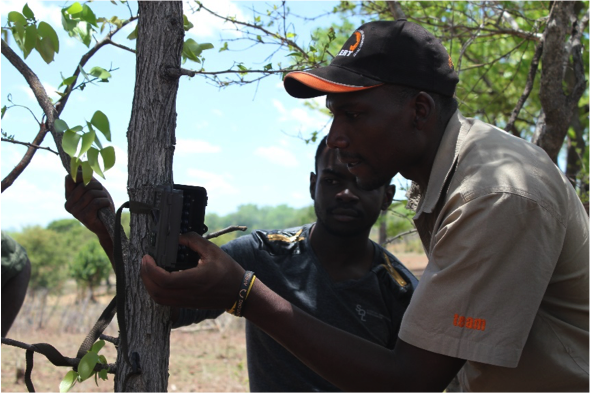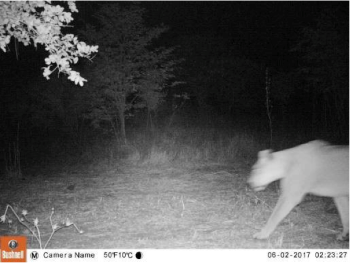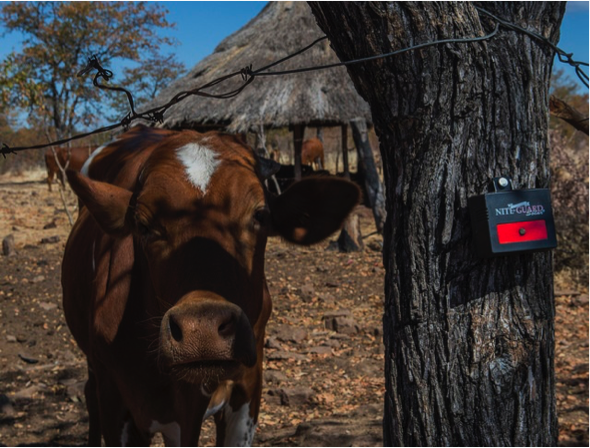Search
ALERT and the Human Wildlife Conflict Update

Monday 02 January 2017
Press contact
Over a year and a half into ALERT and CU’s program to reduce human-lion conflict within Zimbabwe’s Matetsi Conservancy, the database of images captured on specially-installed camera traps outside selected homesteads is growing steadily. Among pictures of smaller predators, such as genets, civets, servals and bush cats, several clear images of lions - along with black-backed jackals and hyenas - have been captured.
In all, nine households are currently fitted with motion sensor camera traps to accompany a flashing lighting system to deter lions and other predators from approaching lit corrals at night. These interventions are part of a monitoring programme to record predator visits and attacks in order to assess the effectiveness of the system. The programme was set up in response to ongoing conflict between communities and predators, mainly lions, which were attacking livestock and being killed by homesteaders in retaliation. The light system consists of a small LED infrared flashing light with a light sensor and is based on Kenyan Richard Turere’s lion lights designed to prevent night-time attacks on his family’s corral.

Lions have been recorded approaching four different homesteads on several occasions since the beginning of 2016, but no actual attacks were reported, suggesting that the lights have been effective in deterring them. The image below is of an adult female taken in the early hours of the morning.
The programme now needs to be expanded to include a further three homesteads which have lights installed but are currently without the camera traps, and also monitoring of other households within the conservancy where lights have not yet been supplied so they can act as a control group with which to compare data.

A student from CU is in the final stages of analysing all data collected to date. This includes 28 interviews with homestead owners, all reports of predator visits, and camera trap images (involving painstakingly sifting through 72GB of images; more than 10,000 in total).
The main question being tested is: What makes some homesteads apparently more vulnerable to livestock predation than others and have the lights had a deterrent effect in homesteads since they were installed? As most of the camera trap images of predators are from the same four households, finding an answer to this question could impact future conflict mitigation methods.
Although analysis is incomplete at this stage, earliest findings suggest the following:
- Most livestock losses (around 75% overall) are actually occurring in rangeland, suggesting that additional mitigation work is required to try and stem this problem.
- The highest proportion of livestock losses from kraals (48%) was goats.
- All kraal kills of cattle, goats, and donkeys were by lions.
- Lion attacks are more frequent in the wet season than in the dry season.
- The strongest predictor of losses of cattle and goats is simply the number of cattle and goats owned in the first place; households with bigger herds appear more vulnerable to losses by lions, which may be preferentially attracted to them.
- Losses of cattle were less frequent in households in closer proximity to each other, suggesting that being less isolated might be one way to minimise attacks.
- Physical deterrents, such as strong kraals, seem to be effective in mitigating night attacks by jackals and hyenas, but are not able to prevent attacks by lions.
As these findings are based on a very limited data set, they must be treated as preliminary in nature. The intention over the course of the next year is to conduct a further 10 interviews per month, expanding the database to about 150 households and providing a much more meaningful set of data for further analysis.

Previous interviews conducted with homestead owners to establish a basic history of livestock predation have revealed that most livestock losses occur during the day when animals are grazing. Therefore, the next stage of this project is to attempt to reduce daytime attacks on livestock in open rangeland. To do so, it first needs to be established where and when these attacks are taking place and the factors that make an attack more likely. Farmers will be trained in how to monitor, collate and interpret attacks using low-cost technology as they herd their livestock. EpiCollect is a freely available app that enables smartphone-based data collection. A similar protocol is already being employed with villagers in Zimbabwe to report incidences of elephant conflict. Livestock attacks, cattle movements and reports of predator sightings will be monitored and this data used to develop effective, low-cost mitigation strategies for local communities. Once set up, monitoring can continue indefinitely, provided airtime for the smartphones is available to the herders.
A significant element of any successful human-wildlife conflict mitigation programme is its work with local people to help them to better understand and manage conservation risks in their own communities. In the Matetsi Conservancy, conservation education is delivered to children - the next generation of homesteaders - to improve attitudes to conservation generally and to lions specifically. A recent donation of footballs, netballs and volleyballs was made by ALERT to one of the schools who are benefitting from this programme.
Having a steady supply of batteries to keep the camera traps operational is proving a drain on limited resources. With each one capturing many images on a daily basis, battery power is depleted quickly. As the aim is to expand the number of cameras to allow the programme to be wider-reaching, this will only become more of a challenge. ALERT and CU welcome donations to help support this aspect of the programme here.
ALERT is also looking for a Wildlife Conservation Research intern to join this programme for a 12-month period to assist the research team in Zimbabwe. The role would involve being responsible for collecting data and engaging with the community. There is a cost involved and an application procedure to follow.
Email intern@lionalert.org for details.





